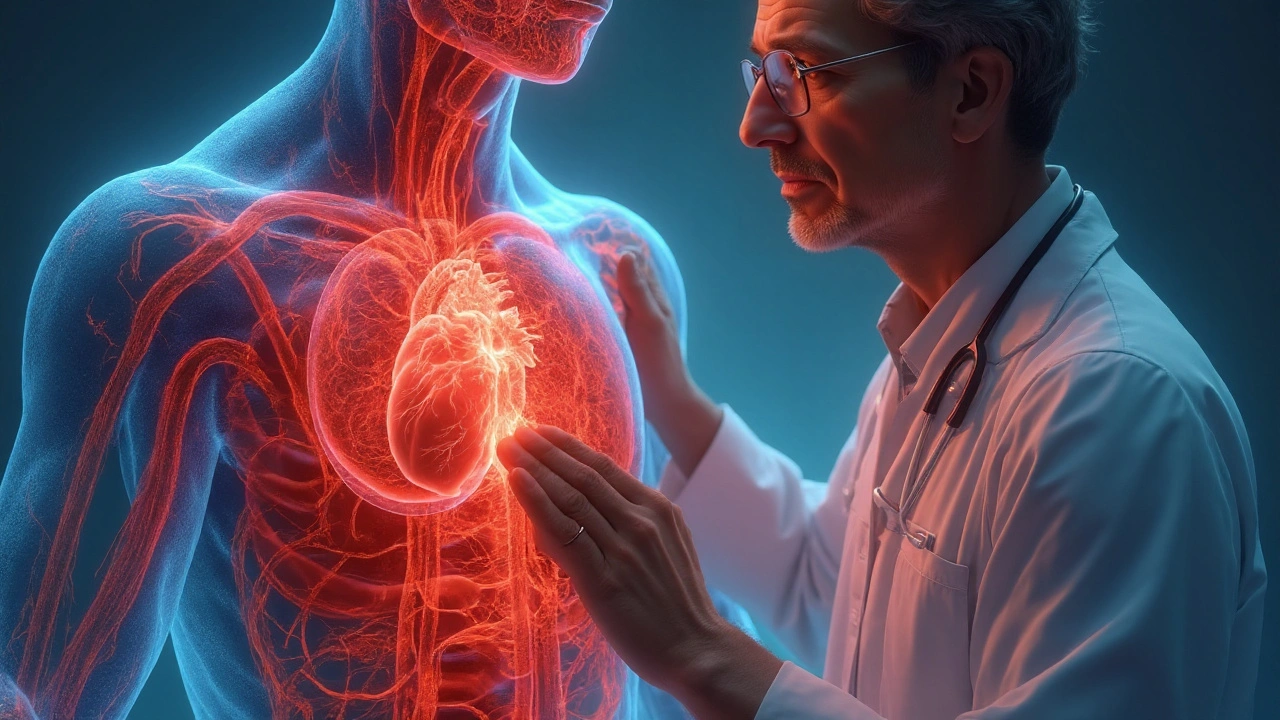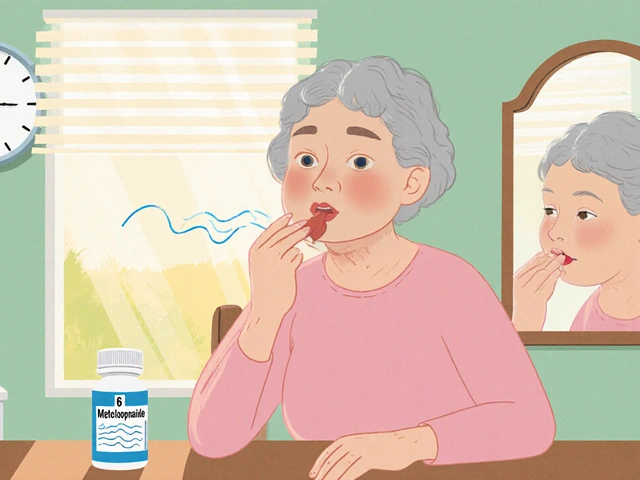Ischemia Knowledge Quiz
Ischemia is a medical condition where blood flow-and therefore oxygen-to a tissue is insufficient to meet its metabolic needs, usually caused by narrowed or blocked arteries. When cells don’t get enough oxygen, they can’t function properly and may die, leading to serious health problems.
Quick Takeaways
- Ischemia occurs when blood supply to an organ is reduced.
- Common causes include atherosclerosis, blood clots, and arterial spasms.
- Symptoms vary by organ: chest pain for heart, leg cramps for limbs, dizziness for brain.
- Diagnosis relies on imaging, stress tests, and blood markers.
- Treatment ranges from medication and lifestyle change to procedures like angioplasty or bypass surgery.
What Triggers Ischemia?
Three major mechanisms drive the reduced blood flow that defines ischemia:
- Atherosclerosis - a buildup of plaque (cholesterol, calcium, and cellular debris) inside arterial walls, narrowing the lumen and restricting flow.
- Thrombosis - formation of a blood clot that can suddenly block an already narrowed artery.
- Arterial spasm - temporary tightening of the smooth muscle in the vessel wall, often triggered by cold, stress, or certain drugs.
Risk factors such as smoking, high LDL cholesterol, hypertension, diabetes, and sedentary lifestyle accelerate these processes. A 2023 Australian cardiovascular study found that 45% of adults over 45 have detectable atherosclerotic plaques, a key predictor of ischemic events.
How Ischemia Manifests in Different Organs
Because every organ has a unique blood demand, the symptoms of ischemia differ greatly. Below are the three most common forms.
Coronary artery disease (CAD) - when the coronary arteries supplying the heart become narrowed.- Typical symptom: angina - a pressure or squeezing sensation in the chest, often triggered by exertion.
- Advanced ischemia can lead to myocardial infarction (heart attack).
- Typical symptom: intermittent claudication - cramping pain while walking that eases with rest.
- Severe cases cause critical limb ischemia, a risk factor for amputation.
- Typical symptom: transient ischemic attack (TIA) - brief neurological deficits like weakness, slurred speech, or vision loss.
- Unresolved ischemia can progress to an ischemic stroke.
Diagnosing Ischemia: From Simple Tests to Advanced Imaging
Early detection prevents irreversible damage. Doctors combine clinical assessment with several tools:
- Electrocardiogram (ECG) - records electrical activity of the heart; ST‑segment changes hint at myocardial ischemia.
- Stress testing - treadmill or pharmacologic stress reveals exercise‑induced ischemia.
- Doppler ultrasound - evaluates blood flow velocity in peripheral arteries.
- CT angiography - 3‑D view of arterial narrowing; high sensitivity for coronary and cerebral vessels.
- Blood biomarkers like troponin indicate myocardial cell injury if ischemia has already caused damage.

Treatment Options Across the Spectrum
Therapy is tailored to severity, location, and patient risk profile. The main pillars are lifestyle, medication, and invasive procedures.
Lifestyle Modifications
- Smoking cessation - cuts risk of clot formation by ~50% within a year.
- Adopt a Mediterranean‑style diet - rich in omega‑3, reduces LDL by ~10%.
- Regular aerobic exercise - improves endothelial function and can regress plaque.
Medication Strategies
Common drug classes include:
- Antiplatelet agents (e.g., aspirin, clopidogrel) - prevent thrombus formation.
- Statins - lower LDL cholesterol, stabilize plaque, and reduce major cardiovascular events by ~25%.
- Beta‑blockers - decrease heart workload, useful in chronic angina.
- ACE inhibitors or ARBs - control blood pressure and improve arterial compliance.
Invasive Interventions
When medical therapy isn’t enough, procedures restore flow directly.
- Percutaneous coronary intervention (PCI) - balloon angioplasty followed by stent placement; success rate >90% for single‑vessel CAD.
- Coronary artery bypass grafting (CABG) - surgical rerouting of blood using vein or artery grafts; preferred for multi‑vessel disease.
- Endovascular thrombectomy - mechanical removal of clot in acute cerebral ischemia; improves stroke outcomes when done within 6hours.
- Peripheral angioplasty or atherectomy - open blocked leg arteries, often followed by drug‑coated balloons to prevent restenosis.
Comparing Major Types of Ischemia
| Condition | Typical Cause | Signature Symptom | Primary Diagnostic Test | First‑Line Treatment |
|---|---|---|---|---|
| Coronary artery disease | Atherosclerotic plaque in coronary arteries | Chest pain (angina) on exertion | Stress ECG or CT angiography | Antiplatelet + statin + lifestyle |
| Peripheral arterial disease | Arterial narrowing in lower limbs | Leg cramping while walking | Doppler ultrasound | Exercise program + antiplatelet therapy |
| Cerebral ischemia (TIA/Stroke) | Thrombo‑embolism or severe stenosis in cerebral vessels | Transient neurological deficit | CT/MR angiography | Anticoagulation + urgent reperfusion if acute |
Managing Ischemia Long‑Term: Monitoring and Prevention
Even after successful treatment, recurring ischemia remains a risk. Follow‑up plans typically include:
- Annual lipid panel - keep LDL < 70mg/dL for high‑risk patients.
- Blood pressure check - target < 130/80mmHg.
- Periodic stress testing or ankle‑brachial index for PAD patients.
- Medication adherence counseling - up to 30% of patients discontinue statins without guidance.
Telehealth platforms now allow remote heart‑rate and peripheral‑pulse monitoring, catching early drops in perfusion before symptoms appear.
Related Concepts and Next Steps
Understanding vascular remodeling helps explain why plaques sometimes stabilize after aggressive lipid‑lowering therapy. Exploring endothelial function testing offers another avenue to gauge cardiovascular risk beyond traditional scores.
Readers interested in deeper dives may explore topics such as:
- “Mechanisms of Atherosclerotic Plaque Rupture” - a narrower look at why some plaques cause sudden clots.
- “Role of Platelet Inhibition in Acute Ischemic Stroke” - bridges neurology and cardiology.
- “Lifestyle Intervention Trials in Peripheral Arterial Disease” - evidence‑based exercise prescriptions.
Key Takeaways
Ischemia is a common, potentially life‑threatening condition that stems from reduced blood flow due to plaque, clots, or vessel spasm. Symptoms vary by organ, but early detection through simple tests and modern imaging can guide effective treatment-from medication and lifestyle change to cutting‑edge procedures like PCI and thrombectomy. Continuous monitoring and risk‑factor control are essential to keep the blood flowing and prevent future episodes.

Frequently Asked Questions
What is the difference between angina and a heart attack?
Angina is chest pain that occurs when the heart muscle temporarily receives less oxygen, usually during exercise or stress. It resolves with rest or nitroglycerin. A heart attack (myocardial infarction) means part of the heart muscle has died because blood flow was completely blocked, often indicated by persistent pain, elevated cardiac enzymes, and ECG changes.
Can a healthy diet really reverse arterial plaque?
While no diet can magically dissolve plaque, studies such as the 2022 CANTOS trial show that a Mediterranean‑style diet combined with statins can reduce plaque volume by up to 15% over two years, improving arterial flexibility and lowering ischemic risk.
When is angioplasty preferred over bypass surgery?
Angioplasty (PCI) is usually chosen for single‑vessel disease, patients with higher surgical risk, or when rapid symptom relief is needed. Bypass surgery is favored for multi‑vessel disease, left main coronary artery blockage, or when long‑term graft patency offers better outcomes.
What lifestyle changes cut the risk of peripheral arterial disease?
Quitting smoking, walking 30 minutes most days, maintaining a BMI below 25, and eating a diet low in saturated fat all lower PAD risk. A 2021 Australian cohort found a 40% reduction in PAD incidence among participants who adhered to a structured walking program for 12months.
How quickly must a clot be removed in acute cerebral ischemia?
The window for mechanical thrombectomy is up to 6hours from symptom onset for most patients, but selected cases up to 24hours can benefit if advanced imaging shows viable brain tissue (the “penumbra”).





9 Comments
Jessica Hakizimana
Wow, reading through that deep dive on ischemia feels like a crash course in how our bodies keep the lights on.
It’s amazing how just a tiny plaque can throw the whole system off balance.
Remember, every step you take toward a healthier diet is a step away from those blockages.
Even if the science sounds heavy, think of it as a puzzle you can solve one piece at a time.
Stay motivated, keep moving, and your arteries will thank you later! 😊
peter derks
Hey folks, if you’re wondering where to start, I always say the simplest thing wins: get your feet moving.
Walking briskly for 30 minutes a day spikes the blood flow and teaches the endothelium to relax.
Pair that with a Mediterranean plate – olive oil, fish, nuts – and you’re basically giving your vessels a spa day.
Don’t forget to schedule that yearly lipid panel; catching a rise early changes the game.
And if you ever feel that cramp in your calves, it’s a sign to dial back and check your ABI.
Sarah DeMaranville
One could argue that the entire discourse on ischemia is merely a rehash of textbook jargon.
Edward Leger
Reflecting on the walking recommendation, it’s interesting how regular aerobic activity can actually remodel arterial walls over months.
The shear stress induced by steady flow promotes nitric oxide release, enhancing vasodilation.
Thus, the simple act of stepping outside carries a molecular message to our endothelium.
In that sense, lifestyle truly becomes a form of medicine, echoing the ancient philosophy that “the body is a vessel of the soul”.
Keyla Garcia
Brace yourselves, because the saga of ischemia is nothing short of a medical thriller! 🎬 The moment a plaque decides to corner an artery, it's like a traffic jam on the highway of life.
Imagine cells screaming for oxygen, and you’re the dispatcher trying to reroute the flow.
First, the body sends out subtle clues: a tug on the chest, a dull ache in the legs, or a fleeting fog over the brain.
If you ignore these whispers, the drama escalates to full‑blown infarction, where tissue dies and the story takes a tragic turn.
But fear not, the heroes of modern medicine have entered the stage – statins, antiplatelets, and the ever‑daring angioplasty catheters.
Statins act like peacekeepers, calming the volatile plaque and even shrinking it over time.
Antiplatelet agents are the vigilant guards, preventing rogue clots from forming when the vessel wall cracks.
When the blockage refuses to yield, PCI swoops in with a balloon that inflates like a tiny dragon, clearing the path, followed by a stent that holds the gate open.
For the mind’s arteries, mechanical thrombectomy is the ultra‑fast rescue team, arriving within a window that feels like a countdown timer in an action movie.
And let’s not overlook the backstage crew: diet, exercise, and quitting smoking – the unsung supporters that keep the plot moving in the right direction.
Studies from Australia in 2023 show nearly half of adults over 45 carry silent plaques, a statistic that reads like a warning sign before the curtain rises.
Yet, with regular check‑ups, lipid panels, and blood pressure monitoring, we can catch the villain before it strikes.
Telehealth now offers real‑time pulse tracking, turning every heartbeat into a data point for early intervention.
So, whether you’re a patient, a clinician, or just a curious observer, remember that ischemia isn’t just a disease – it’s a narrative we can rewrite with every healthy choice we make. 🌟
Ismaeel Ishaaq
Absolutely love the cinematic spin – it reminds us that every step toward a heart‑healthy diet is a plot twist in our favor! 🌈
Jesse Goodman
Quick tip: keep your cholesterol under 70 mg/dL if you’re high risk, and don’t skip that daily aspirin unless your doc says otherwise. 😎
Antara Kumar
While the blanket advice sounds solid, one must remember that universal aspirin therapy can increase bleeding risk, especially in populations with genetic variations in platelet function.
John Barton
Because who doesn’t love a good artery blockage lecture on a lazy Sunday?